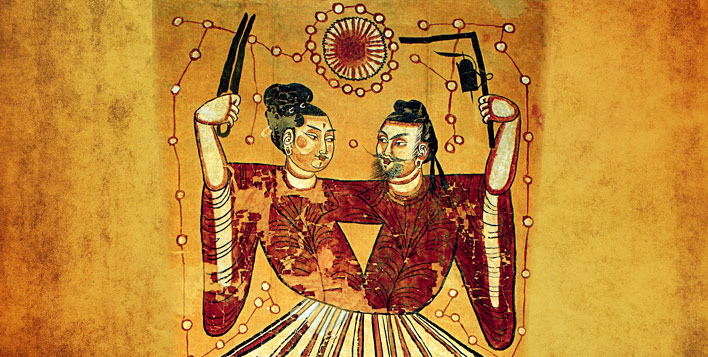
Ancient China
The Five Emperors
The Five Emperors may be thought of more as supreme beings rather than “emperors.” They were morally perfect. Yao and Shun, along with Yu the Great founder of the Xia dynasty, were considered to be model rulers and moral exemplars by Confucians in later Chinese history.
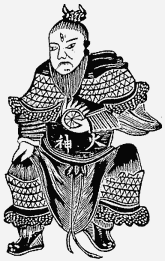
Huangdi (The Yellow emperor), Circa 2698–2598 BCE
The first of the Five Emperors was the Yellow Emperor (in Chinese: Huangdi, pronounced “hwahng dee”). The character “di” originally represented an individual more like a shaman. Huangdi arrived on the scene eight generations after Shen Nong.
He came to power by defeating a corrupt king and winning the allegiance of all the powerful lords. He went on to reign for a hundred years. Many of the Yellow emperor stories are about his wars with rival chieftains who tried to invade his territories.
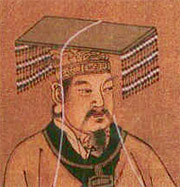
The Yellow emperor was seen by later generations as the paragon of a ruler. He chose to surround himself with talented advisors, whatever their background, who are credited with many epoch-making achievements. They developed mathematics and astronomy, and established the historical calendar based on a sixty-year cycle. They invented a system of writing and promulgated a code of written laws, and invented the classical musical scales. They improved techniques of building and tool-making, and invented new measuring instruments.
The Yellow emperor’s name is attached to the most ancient Chinese medical text, which presents discussions between the emperor and his court physician on the diagnosis and treatment of diseases. His wife Lei Zu devised the techniques of rearing silk worms and weaving cloth from silk.
Zhuanxu (Mythical Reign), Circa 2514–2436 BCE
Emperor Zhuanxu was the grandson of the Yellow emperor, and claimed as the founder of the Qin Dynasty and an ancestor by many of the subsequent dynasties. He ruled for seventy-eight years until his death. He made contributions to a unified calendar and to astrology; initiated religion reforms to oppose shamanism; and forbade close-kin marriage.
Kù, Circa 2436–2366 BCE
When Ku was selected by his uncle, the emperor Zhuanxu, to become an advisor and inherited his uncle’s throne 15 years later, when he was only 30.
His reputation was of a virtuous, righteous, and humble man, one whose actions were always just, and who treated all his people equally. The emperor also had great respect for both the gods in heaven and the underworld, often praying to them in return for prosperity of his people. Under his rule, his people lived happy lives.
The emperor Ku was said to be extremely fond of music. Under his auspices, musicians created many famous musical pieces and invented several new musical instruments. We are told that rare birds such as the phoenix often gathered in his palace to join in musical events. He was said to travel by riding a dragon in spring and summer, and a horse in autumn and winter. He was father to the next emperor, Yao.
Yao, Circa 2350 BCE
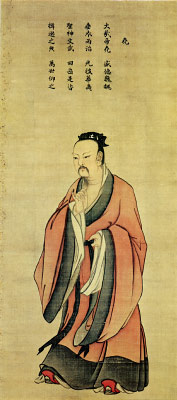
When the later Confucian political philosophers discussed their ancient history they always invoked Yao (rhymes with “wow”) and Shun (“shwoon,” with oo as in “foot”). Han dynasty scholars placed these individuals in the 24th and 23rd centuries BCE.
Yao focused on building political cohesion. He strengthened the bonds between the clans and lineages, and created harmony among the villages and towns, so that “the black-haired people were satisfied and at peace.” He appointed people to study astronomy and calculate the calendar that regulated the seasonal activities of the population. His reputation was encapsulated by the historians thus: “He extended virtue from himself to the world at large.”
Yao inherited the throne from his father and older brother, but he is remembered above all for how he arranged for his power to be passed on. Knowing that his own son was unworthy of leadership, Yao selected a virtuous and talented common man to succeed him—this was Shun. Yao spent thirty years shaping Shun into a worthy successor, entrusting him with many difficult political tasks. Finally. Yao abdicated in his favor and Shun became emperor.
Shun, Circa 2250 BCE
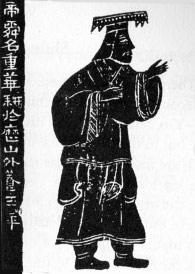
Shun campaigned against “the barbarians” within his territories, people who did not follow a settled agricultural way of life, and expelled them to the remote borderlands of the realm. As a ruler he was known for promoting to positions of authority only people of integrity and simple conduct – fair-minded, public spirited, compassionate, wise and harmonious people.
One of the stories of Shun—told by a philosopher against him!—tells of his leadership style. There was a farming village troubled by land disputes, so Shun went there to live among the people as a farmer. In a year the boundary conflicts ceased. There was a fishing village wracked by quarrels over fishing rights along the riverbank; Shun went there to live as a fisherman. In a year the quarreling ended and an orderly system of sharing was in place. There was a village of potters whose wares were misshapen, and Shun went there and lived a year as a potter, after that the pottery from the village was made correctly.
Yao and Shun were greatly revered over the centuries. Unlike the others, they performed no miracles or amazing feats, but governed their people by virtue of their exemplary behavior. According to The Canon of Yao and Shun, Yao “was reverent, intelligent, accomplished, sincere and mild. He was sincerely respectful and capable of modesty.” Shun was noted for his self-control and moderation. When Yao consulted the gods about his successor, Shun was described as “the son of a blind man. His father is stupid, his mother deceitful, his half brother Xiang is arrogant. Yet he has been able to live in harmony with them and be splendidly filial. He has controlled himself and has not come to wickedness.”
In the chaos of the Axial Age, Yao and Shun were seen as paragons of virtue who had established a golden age of peace.
Karen Armstrong says in The Great Transformation, “Their legend in the Classic of Documents was clearly a tacit criticism of rule based on force and coercion and inherited by dynastic succession. Instead of clinging to their own status and prestige, Yao and Shun had both put the good of the people before their natural preferences. They were the archetypal models, who exemplified the moderation, modesty, self-control, and reverence that the li were supposed to cultivate. The legend of Yao and Shun continued to be an inspiration when the political life of China became even more self-serving and ruthless. The Axial sages would argue that every single human being had the potential to become like these great men.”
Like Yao before him, Shun found that his own son was not qualified to rule, so he passed the throne to his best official, Yu (rhymes with French vu), often known as “Yu the Great.”
Yu the Great (Dayu), Circa 2200–2101 BCE
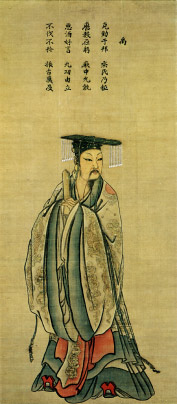
His rule began in 2205 BCE, a time of periodic torrential floods. Under Shun, Gun (the father of Yu) adopted a method of building banks with soil and blocking the holes to control the water, but this no longer worked. Yu was ordered to succeed his father in attempting to control the floods. Drawing from his father’s experiences, he found a way of digging channels to conduct water to the sea. After thirteen years of struggle he finally resolved the problem. Then he organized people to develop agriculture by fully utilizing water and soil. With his son’s help he taught people how to plant rice and other crops and to breed fish, ducks and geese.
Yu is admired not only for his unremitting endeavors to fight against the unpredictable forces of nature but also for forgetting his own interests in order to help other people. Leaving home just four days after his marriage, he did not return for thirteen years, although it is said that he passed by three times.
When Yu died, the people acclaimed his son as ruler, which began the practice of hereditary succession. Yu is counted as the first ruler of the Xia Dynasty (also written Hsia, sounds like “she-yah,” and means “summer”), the first dynasty in the traditional reckoning.
The Xia Dynasty, Circa 2205–1766 BCE
The Xia Dynasty began with virtue and wisdom, and ended with the rule of Jie, who was decadent and cruel.
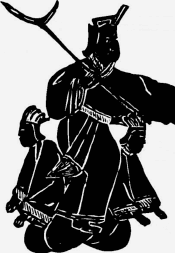
Jie (also written Chieh, pronounced “je-yeh”) was Yu’s antithesis—a tyrant and self-aggrandizing ruler obsessed with power. Jie was a highly intelligent man and very strong physically. He launched one war after another to force the neighboring rulers to pay tribute. He lived in a grandiose palace and dispatched his henchmen to all corners of the realm to bring back rare treasures and exceptionally beautiful girls. He spent his days feasting and wasted food on a grotesque scale. His residence was built so high that it became known as the Tottering Palace.
Jie’s advisors tried to warn him that he was wasting the people’s resources and endangering the realm, but he silenced them by terror, declaring that he was invincible and the whole world belonged to him. He staged arbitrary mutilations to demonstrate his authority. The people hated him and prayed for his downfall, which finally came at the hands of a warlord who had put together a new coalition in a neighboring area and moved to attack him. Jie maintained his arrogant, self-deluded style right up to the day of his defeat. It is said that he took his court ladies to observe the final battle from a hilltop, saying it would be amusing, like watching a hunt.
In 1766 BC, after four hundred years of rule, the Hsia dynasty was overthrown by Tang, who began a new dynasty, the Shang.
